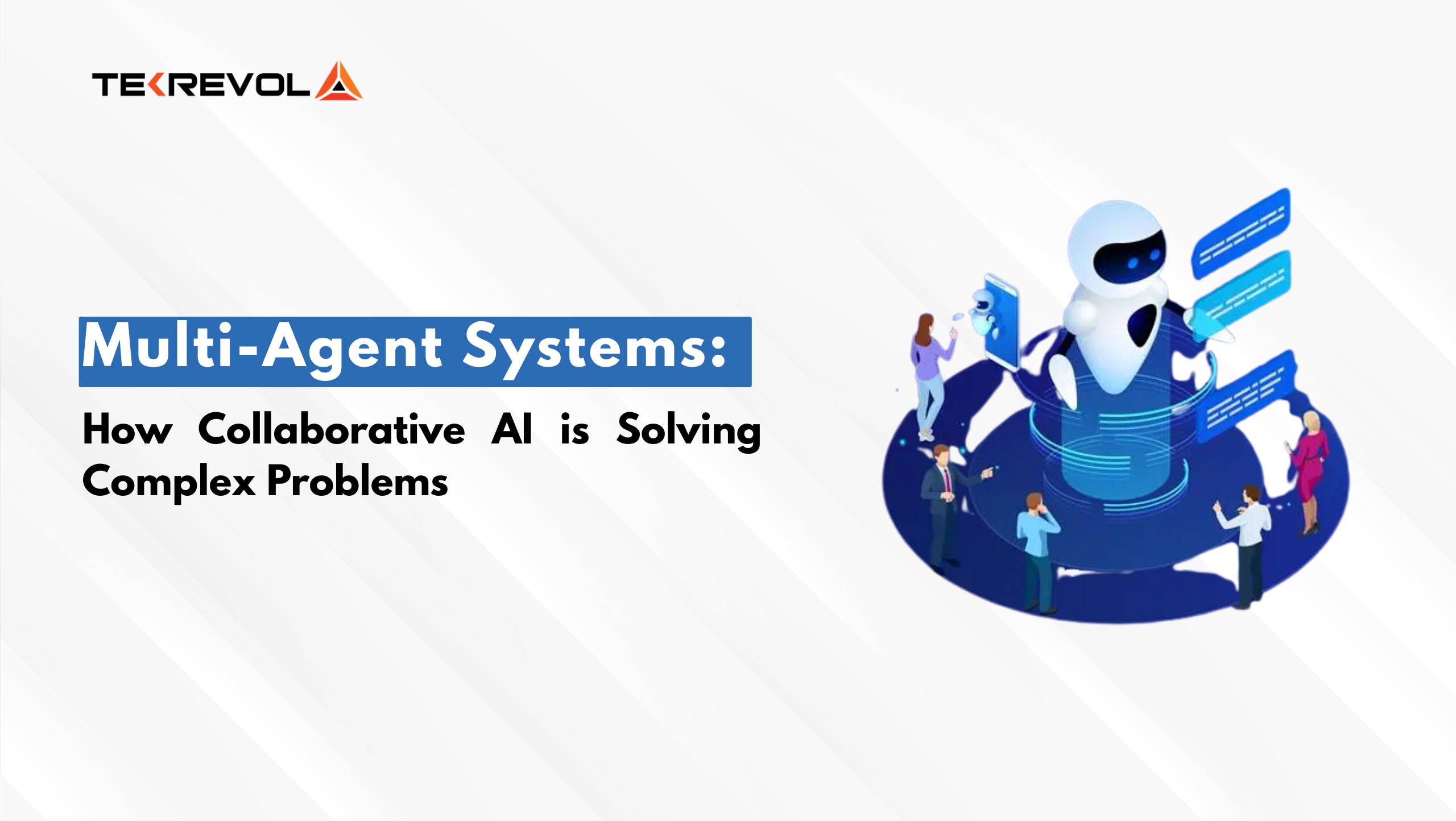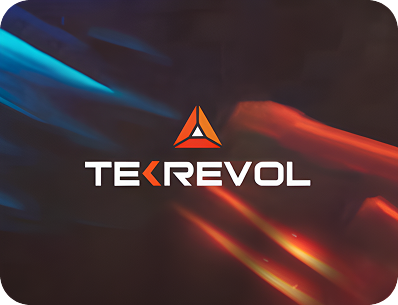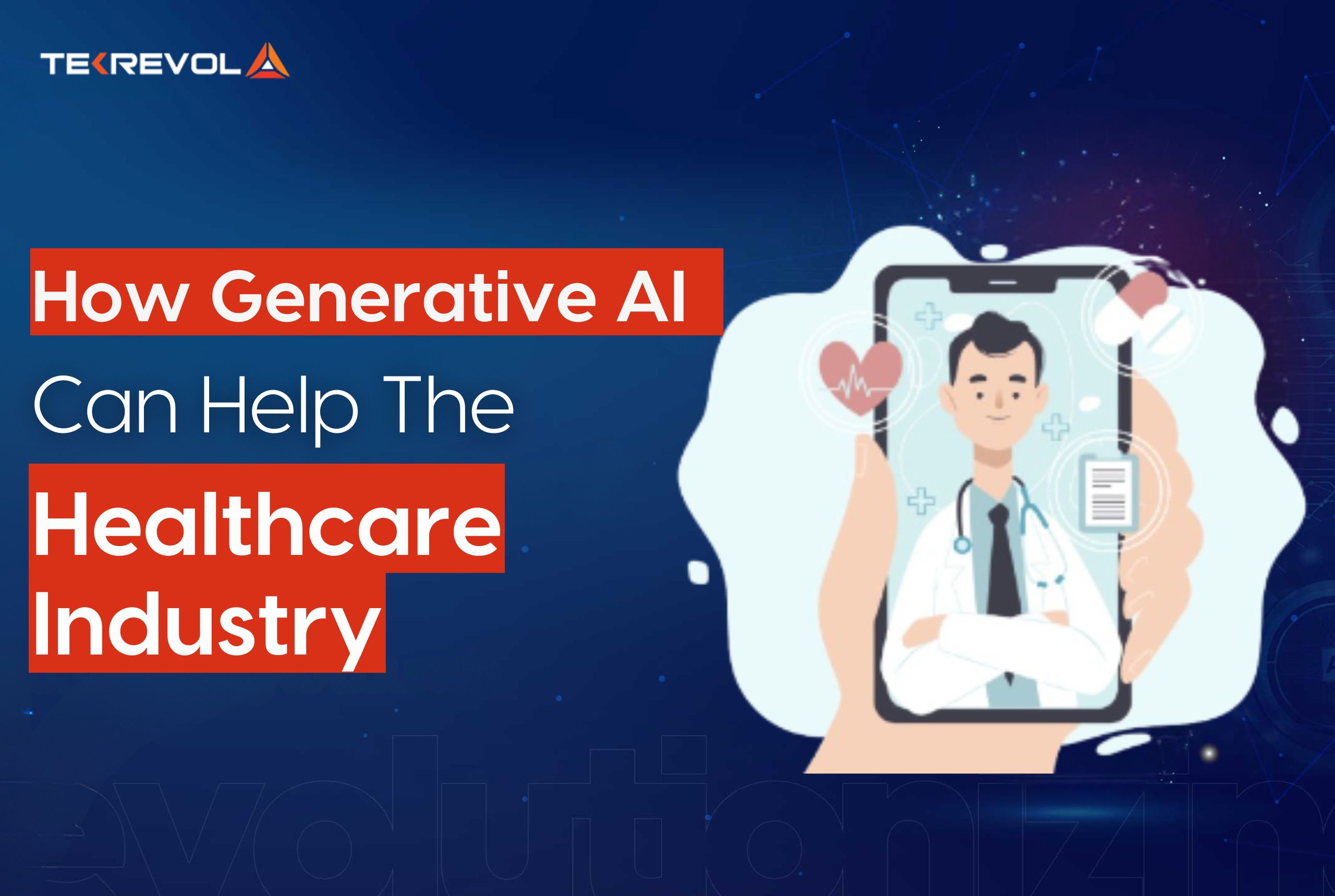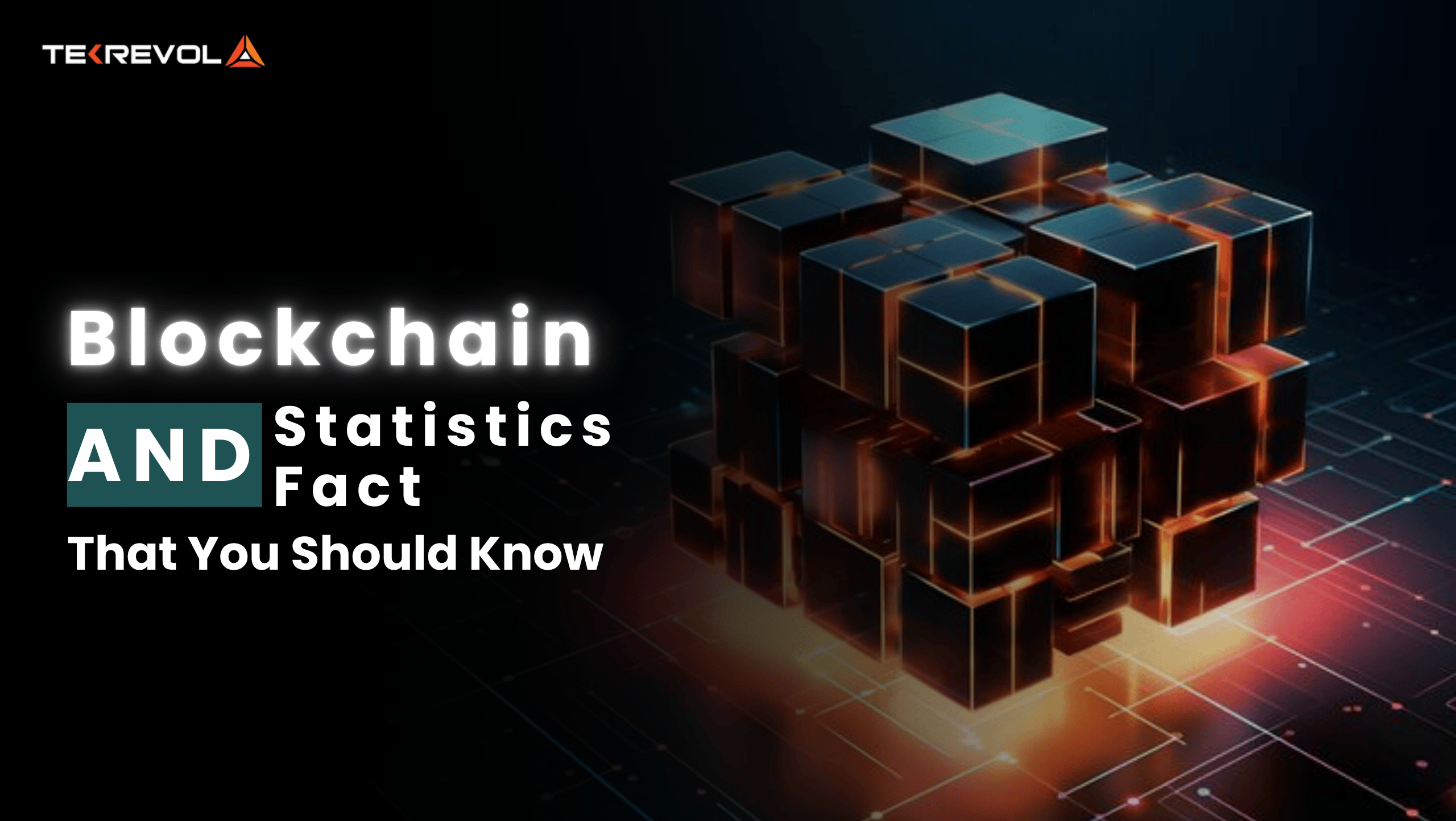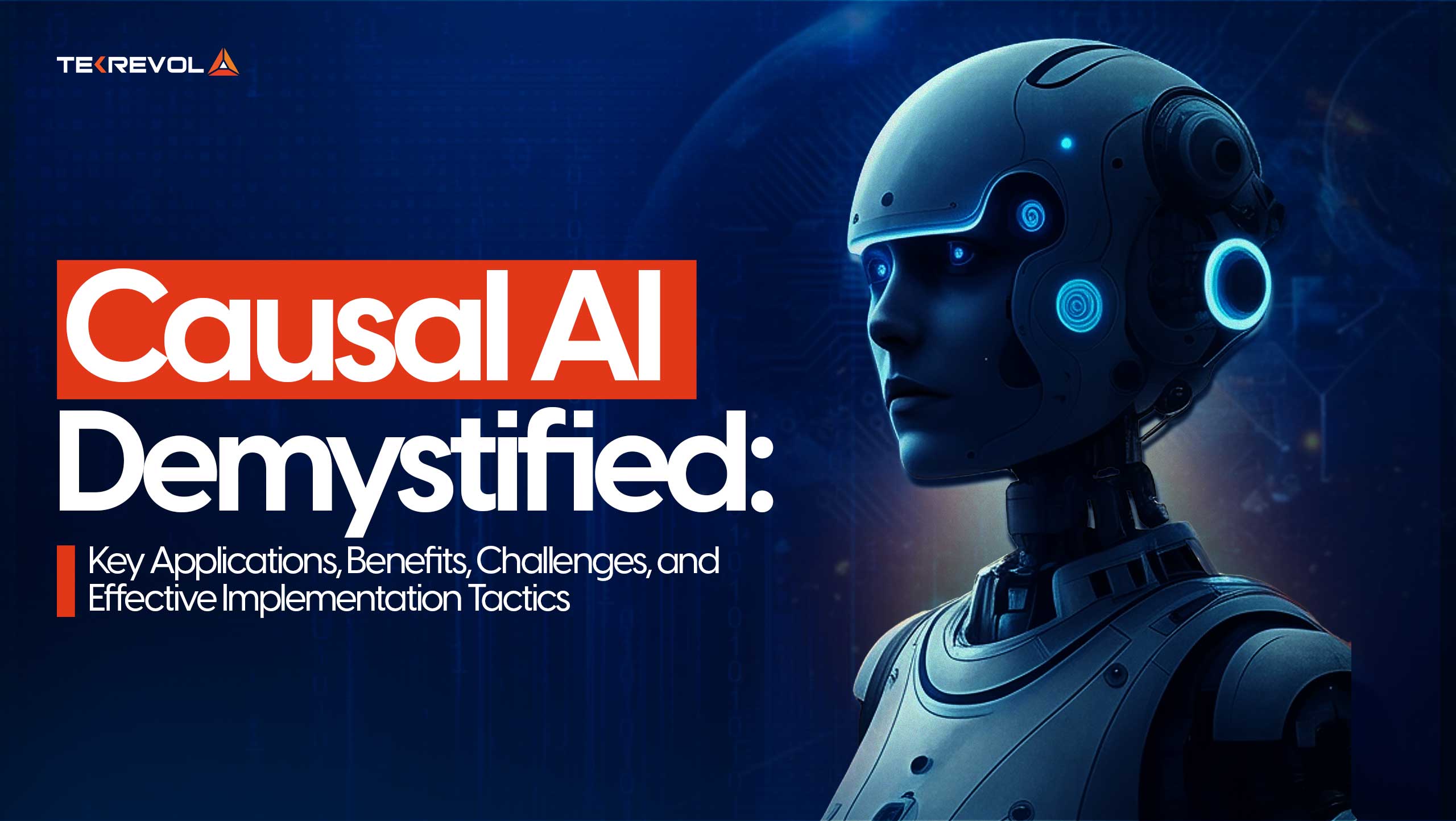AI today is no longer limited to isolated algorithms. With Multi-Agent Systems, multiple intelligent entities communicate and cooperate, addressing complex problems that exceed the capabilities of individual systems.
You must be wondering why we need more AI agents. One AI agent cannot look at the entire picture, but a collection of AI agents with their viewpoints and objectives can learn to collaborate to produce outcomes that are not only quicker but, in many cases, better than conventional methods.
In fact, according to a 2024 report by MarketsandMarkets, the AI Agents Market size was valued at USD 5.25 billion in 2024 and is projected to grow from USD 7.84 billion in 2025 to USD 52.62 billion by 2030, highlighting the increasing reliance on decentralized AI models for real-world problem-solving.
In this blog, we will take you through how multi-agent systems operate, in what scenarios they are currently being utilised, and why they are fast becoming a game changer within the AI landscape.
Companies using Multi-Agent Systems report
2x faster AI decision cycles. TekRevol helps you build MAS-powered solutions that evolve with your business.
Book a Free Strategy Session!What Are Multi-Agent Systems (MAS)?
Multi-Agent Systems, also referred to as MAS, are a number of independent agents working together to fulfill complex tasks that may be cumbersome for one system.
The AI agents are autonomous; however, they exchange information with each other to achieve a common or personal goal, and this makes MAS the ideal application when working in a changing environment like robotics, smart grid, and self-driving cars.
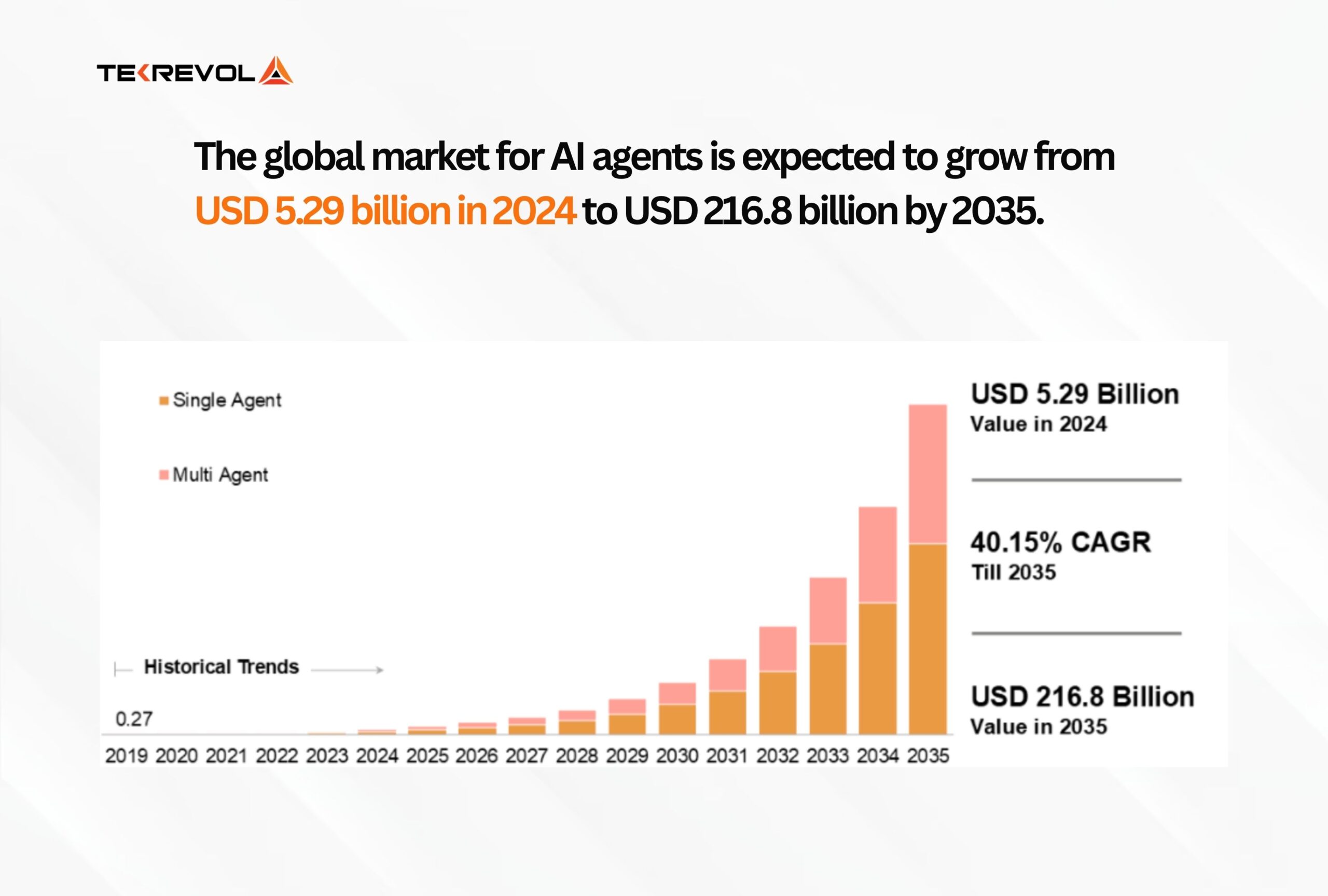
How AI Agents Work Together in MAS?
The functionality of a Multi-Agent System (MAS) depends on the manner its agents collaborate with each other. The collaboration is usually structured in terms of three main functions:
1. Communication
Agents interact on the basis of a pre-determined protocol such as message passing or shared data spaces (e.g., blackboards). This allows them to stay updated on environmental or any other actions or changes on each other.
2. Coordination
To function effectively, agents must coordinate their actions. Coordination prevents duplication, avoids conflicts, and facilitates effortless task performance, usually by planning or simple negotiation means.
3. Cooperation
When cooperating to achieve a common goal, agents merge their skills or information. This cooperation enables them to perform complicated tasks that a single agent could not perform.
The Evolution of Multi-Agent Systems (MAS): From Research to Real-World Solutions
Multi-Agent Systems (MAS) have come a long way, and have been applied to both experimental models and to useful tools that drive intelligent automation in industries. Let’s take a look at how MAS has developed and why it matters today.
Origins of Distributed AI (Late 1980s)
In the late 1980s, MAS evolved out of Distributed AI systems (DAI). Researchers began looking into the prospect of autonomous functioning among a variety of AI agents to solve a problem collaboratively, which was simply too complex or variable to be handled by a single system. It began with research that focused on cooperation, decentralization, and flexibility, which still remain key principles of MAS.
From Theory to Application (1990s–2000s)
After changing the way of computing power, the ability to simulate and implement MAS in the real world also changed. In the early 2000s, MAS started to be applied outside the research context. Major developments were:
- MAS search and rescue robot teams
- The financial markets and the automated trading systems
- Scheduling and Distributed AI Systems in Manufacturing and Logistics
These applications showed that MAS had the potential to make systems more efficient and flexible, as well as make decisions within a decentralized environment.
Mainstream Adoption and Real-World Impact
The growing dependency on the IoT and big data has made Multi-Agent Systems one of the fundamental solutions to synchronized decisions among agents.
- Smart grids for electrical supply management
- Autonomous car fleets for route planning
- Supply chains for dynamic inventory and delivery scheduling
- Disaster relief, where agents manage rescue and resource distribution
The extensive deployment illustrates how MAS makes it possible to have scalable, context-specific, and autonomous problem-solving in complex systems.
MAS Today: A Pillar of Collaborative AI
Multi-Agent Systems are now the building block for collaborative AI, where systems not only operate autonomously but also learn and adapt through interaction. As industries continue to shift toward decentralized intelligence, MAS provides a system that’s not only intelligent but strategic, scalable, and responsive.
Types of Agents in Multi-Agent Systems
Every agent in a Multi-Agent System has a distinct function depending on the way it acts, decides, and communicates with others. The following are the primary types of agents that make up collaborative AI systems:
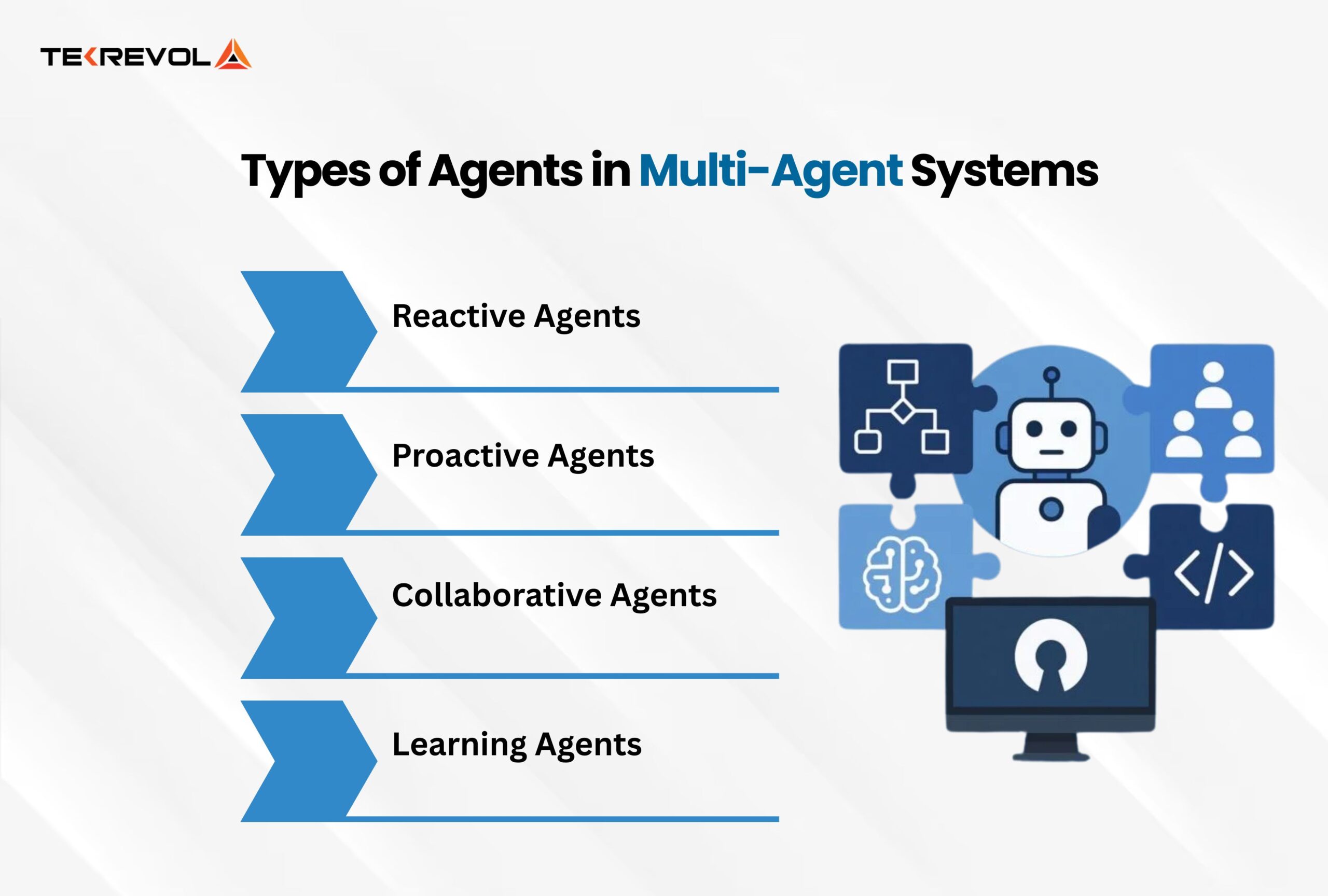
1. Reactive Agents
Reactive agents only operate on the current moment. They react directly to environmental changes without memory or long-term planning.
- Best suited for high-speed environments
- Act according to set rules or stimuli
- Frequently applied in robotics and sensor systems
Example: A vacuum robot that turns around when it bumps into a wall.
2. Proactive Agents
These agents do not merely respond; instead, they plan. Proactive agents act towards goals through projecting forward-looking states and taking intentional steps to achieve these goals.
- Strategic and goal-oriented
- Consider alternatives before acting
- Frequently applied in simulation systems and AI planning systems
Example: An AI assistant that helps plan work of deadlines by scanning your calendar.
3. Collaborative Agents
Collaboration is the core of MAS, and such agents are programmed to coordinate with each other and communicate. They exchange information, negotiate, and frequently operate as a team to crack greater issues.
- Prioritize cooperation rather than competition.
- Share data and make a group decision.s
- Extremely important in supply chains, swarm AI systems, robotics, and distributed AI systems
Example: Drones collaborating to create a map of a disaster area in real time.
4. Learning Agents
Learning agents are adaptive; they change over time based on experience. By extending their behavior through observation of results, they become more likely and effective.
- Employ methods such as reinforcement learning or supervised learning
- Optimize performance with each use
- Central to personalization engines, recommendation systems, and adaptive robots
Example: A recommendation engine that fine-tunes movie recommendations based on ratings.
MAS Architecture: Key Elements That Make It Work
Understanding of core elements of MAS architecture is important to observe how they work effectively in real-world applications.
1. Autonomous Agents
Every MAS contains autonomous multi-network agents, smart components that can sense their environment, decide, and act autonomously.
- They may communicate with other agents and the external system as well.
- Each agent is often given a particular role or set of tasks.
Example: A virtual customer service assistant responds to customer support questions while another agent ships orders in parallel.
2. Shared Operational Environment
The environment is the setting that contains agents and defines how they interact. It determines the rules, resources, and interactions that are feasible.
Instruction:
- It may be a physical area (such as a warehouse with robots) or a virtual space (such as an online store).
- The environment changes all the time, meaning that agents have to sense and react in real time.
3. Communication Protocols
Strong communication protocols are the key to effective agent coordination. Protocols specify how agents communicate, coordinate action, and negotiate roles.
- Agents can communicate using FIPA-ACL or a messaging system customized to the application.
- Guarantees agents stay in sync and do not interfere with each other
- Essential in large-scale MAS with hundreds or thousands of agents
4. Coordination and Goal Alignment
A MAS is effective only if agents are coordinated towards common or complementary goals. Agents are coordinated by coordination mechanisms to prioritize their actions without a central controller.
Example: In an autonomous delivery system, drones and ground transport vehicles coordinate to make multi-step deliveries efficiently.
5. Decision-Making Layer
Contemporary MAS frequently incorporate a reasoning or decision-making component, wherein agents consider choices, learn from results, or refer to global goals before action.
- Both reactive and proactive behavior are supported
- Facilitates greater adaptability in uncertain environments
How Agents Coordinate in Multi-Agent Architectures: Key Strategies
For Multi-Agent Systems (MAS) to be effective, coordination is necessary. Even though every agent acts autonomously, their actions need to be coordinated in order to meet common goals without overlap or contradiction. This is how that coordination is designed:
1. Defining Communication Rules
Prior to collaboration occurring, agents need to decide on a method of communication. This is done by standardized procedures that specify the way information is exchanged.
Examples:
- Contract Net Protocol – application for task bidding and allocation
- Blackboard systems – where agents write and read updates in a common space
These provide a guarantee that all agents comprehend and decode data similarly.
2. Negotiating Roles and Responsibilities
After setting up communication, the agents negotiate roles and responsibilities among themselves for performing different tasks. This is done to ensure efficiency and avoid duplication.
Real-world example: A MAS used in logistics allows agents to discuss and allocate urgent deliveries, taking into account each one’s position, availability, and route.
3. Constructive Conflict Resolution
Conflicts may occur when agents put forward overlapping solutions or have opposing objectives. Coordination methods encompass:
| Method | Description |
| Voting Systems | Agents vote on their preferences to collectively reach a consensus. |
| Priority Rules | Rule-based systems assign tasks to agents based on predefined ranks or priority levels. |
| Learning-Based Models | Agents learn how to respond to conflicts over time through experience or reinforcement learning. |
How Multi-Agent AI Solves Complex Problems?
Multi-agent AI systems are designed to handle complexity by collaborating, being flexible, and making smart decisions. These systems offload work among independent agents, so they are well-suited for dynamic environments. Here’s a closer look at their most significant features:
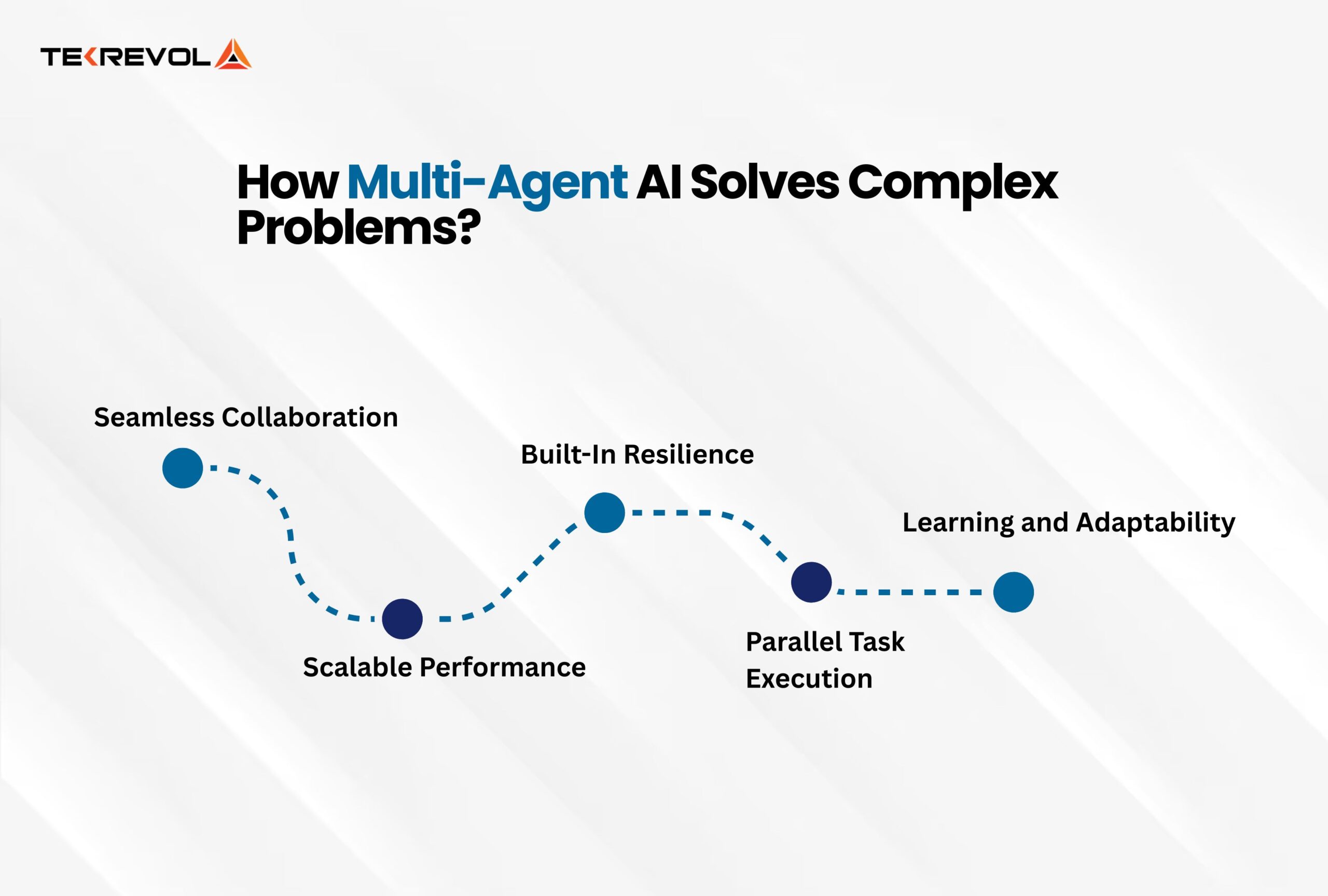
1. Seamless Collaboration
Agents within a MAS exchange information and coordinate to accomplish common objectives. Each agent performs a subset of the task while maintaining group alignment.
Example: In autonomous vehicle networks, cars swap live data to prevent collisions and ease traffic jams. This could reduce traffic crashes by as much as 90%, according to McKinsey.
2. Scalable Performance
Multi-agent systems scale up without efficiency loss. When demand grows, more agents are introduced to continue at optimal performance.
Example: Amazon employs a warehouse robot army to handle inventory and order fulfillment. Warehouse automation is expected to grow to $55 billion by 2030, with technologies like these playing a significant role.
3. Built-In Resilience
These systems are built to keep working even if one or more agents fail. Other agents immediately reconfigure to take their place.
Example: a swarm AI system drone used for wildfire monitoring could self-adjust when individual drones lost GPS, maintaining mission continuity through collaborative AI.
4. Parallel Task Execution
Independent agents execute tasks in parallel, enabling multiple tasks to be executed at a time. This reduces time and enhances throughput.
Example: Example: In the BMW smart factories, the agents perform welding, painting, and inspections concurrently, which improves production by 30 percent and saves costs by 15 percent.
5. Learning and Adaptability
A multi-agent system can learn through experience and gradually change its behavior; therefore, they are suitable in uncertain settings.
Companies are getting actual business returns using AI agents, such as a 30% savings in customer support costs. Even better, 37% of employees report improved collaboration thanks to AI-powered tools.
Real-World Applications of Multi-Agent AI Across Industries
Multi-Agent AI (MAS) is being used increasingly outside the realm of research and academic institutions. Following is how MAS is utilized in major industries:
Explore practical use cases where AI agents deliver immediate business value. Read the full blog now.
Logistics and Supply Chain
MAS allows the logistics sector to manage complex activities by allocating tasks such as inventory tracking, route planning, and delivery planning between agents.
For example, Amazon uses the MAS to manage its sprawling network of warehouses and delivery centers. By individually tracking real-time information, such as package whereabouts, truck status, or traffic conditions, agent by agent, Amazon aims to refine operations, reduce delivery time, and prevent congestion.
Smart Manufacturing
In manufacturing, MAS helps robotic agents collaborate on production lines, track equipment condition, and automatically trigger maintenance schedules.
Example: In a smart factory arrangement, one agent could identify declining machine performance, and another could schedule preventive maintenance, without any human intervention. This reduces
downtime and enhances production reliability.
Healthcare Systems
MAS facilitates more responsive and customized healthcare through the processing of enormous volumes of data and facilitates coordinated decision-making.
Example: Agents can help track patient vitals, identify outliers, and suggest care interventions. For treating chronic disease, MAS assists physicians in customizing treatment regimens and anticipating health risks more accurately.
Check out our complete blog: How Generative AI Can Help the Healthcare Industry to explore its real-world impact.
Gaming & Entertainment
Multi-Agent AI is revolutionizing the game industry by making smarter NPCs and responsive virtual worlds. Such systems make the game more interactive and rich, particularly in multiplayer versions.
According to Statista, the gaming sector reached a $365 billion valuation in 2023, evidence that AI is becoming indispensable in providing richer game experiences.
Intelligent City Infrastructure
MAS is utilized by cities to manage various services such as traffic management, waste management, and energy distribution, all are enhanced through autonomous coordination.
Example: In traffic management, agents can regulate signal timing according to real-time vehicle count, whereas others take public transport schedules into account to reduce congestion. Likewise, MAS in energy grids optimizes usage loads to avoid outages.
Multi-agent AI improves coordination in complex systems by up to 70%.
Our AI experts analyze your workflows and map the right agent-based solutions.
Get your personalized MAS implementation roadmap!Challenges That Require Multi-Agent Over Single-Agent Solutions
Whereas Single-Agent AI is adequate for stand-alone tasks, it fails in dynamic, large-scale, or decentralized settings. Multi-Agent AI (MAS) bridges this limitation by supporting diverse agents operating independently and in concert. The following are major areas where MAS provides real-world benefits:
-
Breakdown of Layered Problems
Single agents are capable only to a limited extent in the case of stacked problems. MAS distributes problems across agents, and they can process them in parallel.
Example: In climate modeling or protein structure prediction, MAS facilitates the distribution of computational load, accelerating analysis without compromising precision.
-
Decentralized Decision-Making
Centralized systems may be slow or wasteful. MAS enables localized decisions while still working towards the goals of the overall system.
Example: MAS is utilized by smart grids to distribute energy loads locally and react more quickly to changes in demand, enhancing reliability.
-
Adapting in Real Time
Single-agent AI can fail in dynamic environments. MAS agents learn to respond to change through feedback from the environment.
Example: Swarm robotics enables groups of robots to move through uncertain environments by making path adjustments according to current conditions.
-
Scalable Simulations
Large models frequently surpass individual agent capacities. MAS provides more effective, distributed simulation.
Example: A publication in Nature confirmed that integrating Multi-Agent AI models into epidemic forecasting reduced computing time by 40%, aiding swift policy formulation.
-
Real-Time Coordination
It is difficult for one agent to manage multiple moving parts in real time. MAS enables the agents to communicate and coordinate well.
Example: Air traffic systems apply principles of MAS to schedule flight routes and cut down on delays through cooperative scheduling.
Challenges in Implementing Multi-Agent AI Systems
While Multi-Agent AI has vast potential, its application in actual systems is far from easy. As organizations transition to decentralized, cognitive networks, they are faced with a number of technical, organizational, and practical issues that hinder adoption.
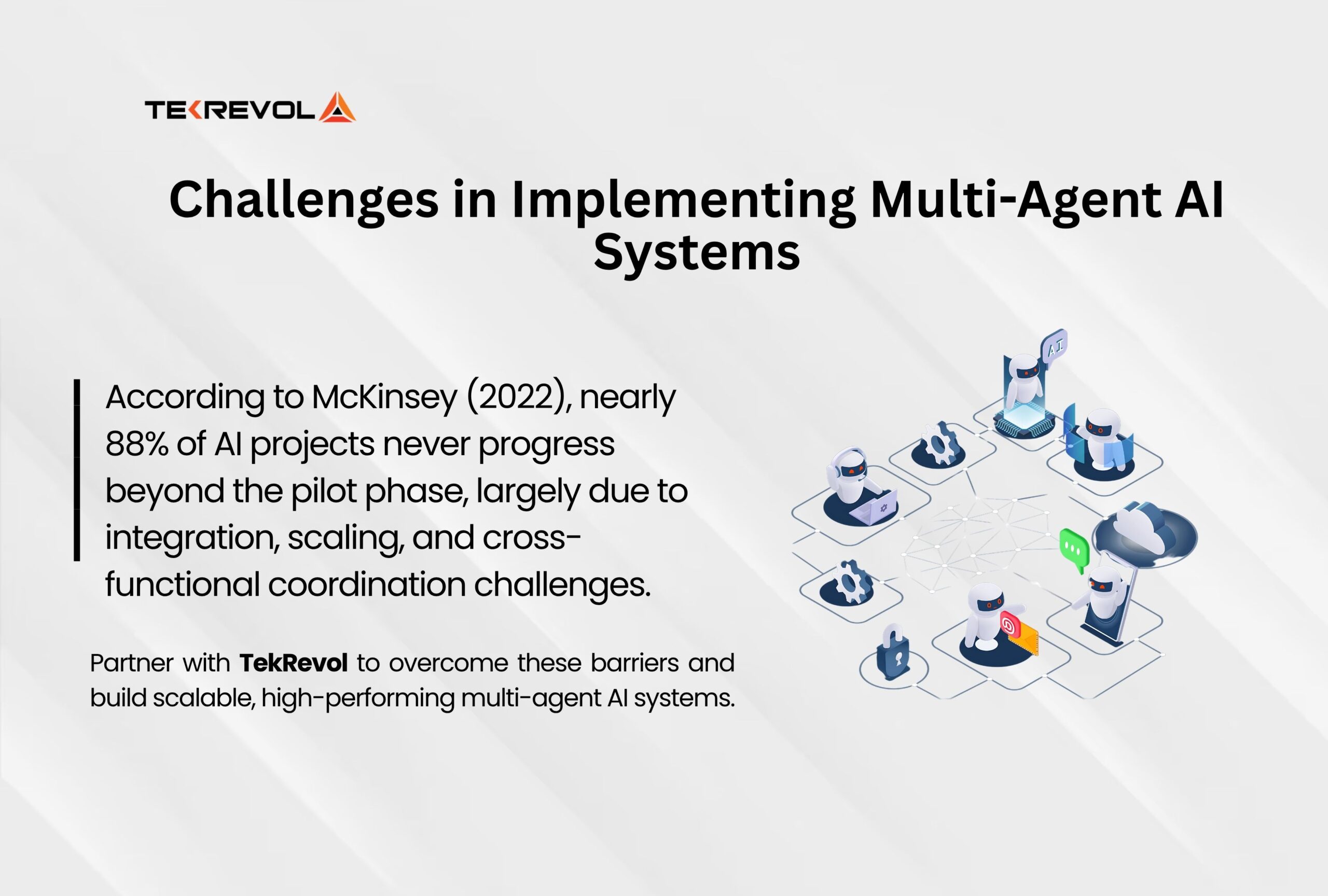
Below are some of the most significant challenges organizations encounter:
1. Increased System Complexity
Unlike single-agent models, multi-agent systems make designers deal with both individual agent reasoning and the group behavior dynamics. It takes layered planning and, typically, domain-specific methods to coordinate agents to operate together without hindrance, making system design much more complicated.
2. Communication Overload
Agents have to communicate in order to coordinate with one another, but excessive communication can impair the system’s bandwidth, delay decisions, and decrease efficiency. Finding the equilibrium between not enough and too much communication is difficult, especially as the number of agents grows.
3. Controlling Agent Conflicts
Deadlocks or inefficiencies can develop when agents seeking the same objective or resources share surroundings. Through processes like negotiation or auctions, resolving these disputes raises operational complexity and calls for robust, immediate decision-making systems.
4. Coordination in Rapidly Changing Environments
Quickly changing circumstances, such as shifting traffic or market trends, can quickly disrupt coordination. If the agents are unable to change in response fast enough, the system may become out of sync, resulting in partial failure or cascaded errors throughout the network.
5. Maintaining Security and Trust between Agents
Why it’s a challenge: When agents are autonomous, particularly in open systems, it’s difficult to ensure that all will act properly or have not been compromised. One malfunctioning or malicious agent can upset outcomes, so imposing trust and security imposes substantial design and monitoring overhead.
40% of enterprise AI leaders are investing in MAS to tackle system complexity.
Future-proof your AI infrastructure with TekRevol’s distributed multi-agent systems.
Book A Free Consultation Now!The Future of Multi-Agent AI: What’s Next?
As the world becomes more decentralized and collaborative, AI systems, Multi-Agent AI will transform how intelligent systems function in various industries.

1. Smarter Communication Protocols
Minimizing communication overhead is essential to enable more coordination among agents. Efficient protocols enhance real-time performance, particularly in high-speed environments.
2. Advanced Learning Capabilities
With reinforcement learning and federated learning combined, agents will not be dependent on centralized training anymore. They’ll be learning on the fly, adjusting for new data streams, and continually perfecting their tactics over time, both individually and as a group.
3. Scalable Architectures
As multi-agent systems grow to thousands, even millions of units in cloud and edge settings, architecture will be a critical factor. Serverless computing, container orchestration (such as Kubernetes), and AI-specialized chips are making it possible for scalable, distributed MAS deployments.
4. Ethical AI Design
MAS development will include ethical frameworks to guarantee agents operate inside moral and legal limits. This includes bias mitigation, open decision-making, and interagent responsibility, all of which are crucial in fields like healthcare, finance, and law enforcement.
Build Your Intelligent Multi-Agent AI System with TekRevol
At TekRevol, we design sophisticated AI agent systems, ranging from basic autonomous agents to intricate multi-agent networks, that can automate processes and improve business performance.
As a leading AI Agent Development company, our multi-agent AI solutions address complex, dynamic issues through real-time coordination and distributed intelligence, while our basic AI agents perform day-to-day automation, analysis, and customer interactions with speed and precision.
Having a track record of delivering enterprise-level AI solutions to industries ranging from logistics to fintech to healthcare, we at TekRevol are trusted for our ability to create scalable, forward-thinking digital solutions.
Want to build your own AI agent? Check out our blog “TekRevol’s AI Agent Playbook: From Strategy to Execution”
We’ve helped businesses implement MAS that scale to millions of users.
Partner with us to future-proof your AI infrastructure with intelligent multi-agent systems.
Book A FREE Call Now!
